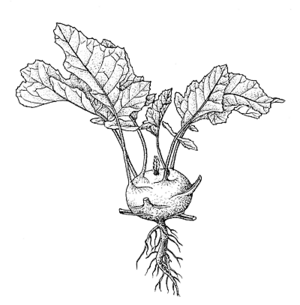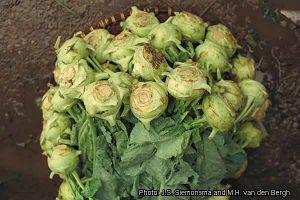Brassica oleracea - kohlrabi (PROTA)
Introduction |
| General importance | |
| Geographic coverage Africa | |
| Geographic coverage World | |
| Vegetable | |
| Medicinal | |
| Ornamental | |
| Forage / feed | |
| Food security | |
Brassica oleracea L. (kohlrabi)
- Protologue: Sp. pl. 2: 667 (1753).
- Family: Brassicaceae (Cruciferae)
- Chromosome number: 2n = 18
Vernacular names
- Kohlrabi, cabbage turnip, knolkhol (En).
- Chou-rave (Fr).
- Couve rábano (Po).
Origin and geographic distribution
The origin of kohlrabi lies in north-western Europe, where it was developed from marrow-stem kale, a fodder crop with a thickened stem. The first record dates from the 16th century. Besides in Europe, North America and temperate parts of Asia, kohlrabi is also grown in subtropical Asia, e.g. in India, China and northern Vietnam. At high elevations in East Africa it is occasionally grown for European clients.
Uses
Kohlrabi is grown for the flattened globose to ovoid swollen stem (stem tuber), which is cut in pieces and cooked, but also used in soups or eaten raw in salads. Industrially it is made into deep-frozen products.
Properties
Kohlrabi stem tubers (peeled thickly, 70% of product as purchased) contain per 100 g edible portion: water 91.7 g, energy 96 kJ (23 kcal), protein 1.6 g, fat 0.2 g, carbohydrate 3.7 g, dietary fibre 2.2 g, Ca 30 mg, Mg 10 mg, P 35 mg, Fe 0.3 mg, Zn 0.1 mg, carotene trace, thiamin 0.11 mg, riboflavin trace, niacin 0.3 mg, folate 82 μg, ascorbic acid 43 mg (Holland, B., Unwin, I.D. & Buss, D.H., 1991). Kohlrabi is rich in glucosinolates; properly prepared it contains per 100 g about 100 mg glucosinolates, mainly indolylglucosinolate. Glucosinolates determine the characteristic flavour and taste, and are known to have anticarcinogenic activity.
Description
- Erect, glabrous, biennial herb up to 40 cm tall at the mature vegetative stage, with unbranched, swollen, tuber-like stem up to 12 cm in diameter, pale green to purplish; root system strongly branched.
- Leaves alternate, simple or with some small side lobes at base; stipules absent; all leaves with distinct, slender petiole; blade ovate in outline, irregularly incised, blue-green.
- Inflorescence a terminal paniculate raceme.
- Flowers bisexual, regular, 4-merous; pedicel up to 2 cm long, ascending; sepals oblong, c. 1 cm long, erect; petals obovate, 1.5–2 cm long, clawed, pale to bright yellow or whitish; stamens 6; ovary superior, cylindrical, 2-celled, stigma globose.
- Fruit a linear silique 5–10 cm × c. 5 mm, with a tapering beak 5–15 mm long, dehiscent, up to 30-seeded.
- Seeds globose, 1.5–2 mm in diameter, finely reticulate, brown.
- Seedling with epigeal germination, with a taproot and lateral roots; hypocotyl 3–5 cm long, epicotyl absent; cotyledons with petiole 1–2 cm long, blade cordate, 1–1.5 cm long, cuneate at base, notched at apex.
Kohlrabi has been classified in convar. acephala (DC.) Alef., as var. gongylodes L. It can best be considered as a cultivar-group and as such has been called Kohlrabi Group.
Ecology
Kohlrabi is adapted to a temperate climate. In north-western Europe production is from March till November, but in subtropical regions (e.g. Vietnam) it is grown during the cool winter season. Only the early types adapted to summer conditions of temperate climates are used for cultivation in high-altitude regions of the tropics or in the cool season of the subtropics.
Management
Seeds are sown on seedbeds or modules. The 1000-seed weight is 3–5 g. Young seedlings may have to be shaded to prevent sun scorching. Seed requirements are 300–700 g/ha. Transplanting to the field should be done when seedlings have 7–9 true leaves, 30–40 days after sowing. Plant densities are 100,000–120,000 plants/ha. In mechanized cultivation kohlrabi may be sown direct at a rate of 1–2 kg/ha and later thinned to a density of up to 300,000 plants per ha. Cultivation practices and use of fertilizers are comparable to cauliflower. Diseases and pests are the same as for the other vegetable Brassica crops. Kohlrabi should be harvested when young (55–65 days after sowing) as the tuber becomes woody and fibrous with age. To obtain a tender, sweet product from spring-sown kohlrabi the stem tubers are picked when 5–6 cm in diameter; those of autumn-grown kohlrabi are less likely to become fibrous and can be harvested when 10–12 cm in diameter.
Yield for fresh market is about 36 t/ha, but for industry yields can be achieved of 100 t/ha. Kohlrabi stem tubers can be stored for about three weeks at 0–1°C and a relative humidity of 98%; topped ones may be stored for 2–3 months under these conditions.
Genetic resources and breeding
Germplasm collections of kohlrabi are available in several genebanks. In Europe a Brassica genebank has been established in cooperation with private companies. A database is available at the Centre for Genetic Resources (CGN), Wageningen, Netherlands.
Seed companies have developed F1 hybrids based on self-incompatibility and a single cross between two inbred lines. The first hybrid based on cytoplasmic male sterility was recently released. The main breeding objectives are uniformity, yield, earliness, colour and stem tuber quality. Important cultivars include ‘Kossak’, ‘Kolibri F1’ and ‘Grand Duke’.
Prospects
Kohlrabi is of minor importance for tropical Africa, but introduction of heat tolerant cultivars (e.g. from northern Vietnam) might lead to some expansion.
Major references
- Holland, B., Unwin, I.D. & Buss, D.H., 1991. Vegetables, herbs and spices. The fifth supplement to McCance & Widdowson’s The Composition of Foods. 4th Edition. Royal Society of Chemistry, Cambridge, United Kingdom. 163 pp.
- Jansen, P.C.M., Siemonsma, J.S. & Narciso, J.O., 1993. Brassica oleracea L. In: Siemonsma, J.S. & Kasem Piluek (Editors). Plant Resources of South-East Asia No 8. Vegetables. Pudoc Scientific Publishers, Wageningen, Netherlands. pp. 108–111.
- Nieuwhof, M., 1969. Cole crops: botany, cultivation, and utilization. Leonard Hill, London, United Kingdom. 353 pp.
- Oregon State University, 2002. Kohlrabi. [Internet] Commercial vegetable production guides, Veg Home. http://oregonstate.edu/Dept/NWREC/kohlrabi.html. Accessed May 2004.
- Salunkhe, D.K. & Kadam, S.S. (Editors), 1998. Handbook of vegetable science and technology: Production, composition, storage, and processing. Marcel Dekker, New York, United States. 721 pp.
Other references
- Buishand, T., Houwing, H.P. & Jansen, K., 1986. The complete book of vegetables. Gallery Books, New York, United States. 180 pp.
- Crisp, P., Crute, I.R., Sutherland, R.A., Angell, S.M., Bloor, K., Burgess, H. & Gordon, P.L., 1989. The exploitation of genetic resources of Brassica oleracea in breeding for resistance to clubroot (Plasmodiophora brassicae). Euphytica 42: 215–226.
- Pelletier, G.R., 1989. Organelle manipulation by hybridization: methods, results and applications. Proceedings of the fifth crucifer genetics workshop. pp. 15–16.
- Shinohara, S. (Editor), 1984. Vegetable seed production technology of Japan. Volume 1. Shinohara's Authorized Agricultural Consulting Engineer Office, Tokyo, Japan. 432 pp.
- Taylor, J.P., 1982. Carbon dioxide treatment as an effective aid to the production of selfed seed in kale and brussels sprouts. Euphytica 31: 957–964.
Sources of illustration
- Jansen, P.C.M., Siemonsma, J.S. & Narciso, J.O., 1993. Brassica oleracea L. In: Siemonsma, J.S. & Kasem Piluek (Editors). Plant Resources of South-East Asia No 8. Vegetables. Pudoc Scientific Publishers, Wageningen, Netherlands. pp. 108–111.
Author(s)
- P. Tjeertes, Kweekwal 21, 1602 ED Enkhuizen, Netherlands
Correct citation of this article
- Tjeertes, P., 2004. Brassica oleracea L. (kohlrabi) [Internet] Record from PROTA4U. Grubben, G.J.H. & Denton, O.A. (Editors). PROTA (Plant Resources of Tropical Africa / Ressources végétales de l’Afrique tropicale), Wageningen, Netherlands.
Accessed 17 December 2024.


